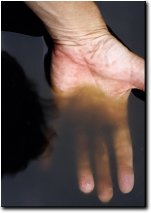|
June 24, 2003
"Black Tide" on St. Leonards Creek, Calvert County. |
||||
| A dense bloom of Karlodinium micrum was identified on St. Leonard’s Creek, Wednesday June 18th. The beginning of the bloom condition was documented one week earlier by Stella Sellner of the Academy of Natural Sciences Estuarine Research Center
On Friday June 20th, a fish kill of silversides was identified in association with the St. Leonard’s Creek mouth related to ponded water that was cutoff from the main channel of the creek during low tide. The fish kill prompted additional investigation of St. Leonard Creek, however, there was no evidence of a broader scale fish health event. Algal samples were again collected and the cell concentrations declined but remained significant at 50,000 cells/ml in the surface water.
Water quality conditions were measured throughout St. Leonard’s Creek during the rainstorm on Friday morning by ANSERC. Dissolved oxygen in the surface water measured 8.1 to 10.5 mg O2/L except at the head of the creek which measured 3.5 mg O2/L. Cloudy conditions Friday likely limited the levels of dissolved oxygen observed which will be expected to increase with sunny weather and may cause severe hypoxia at night with such extreme densities of algae. Bottom waters were severely hypoxic and ranged from 0.1 to 0.25 mg O2/L in the creek and 4.4 mg O2/L at the mouth.
|



